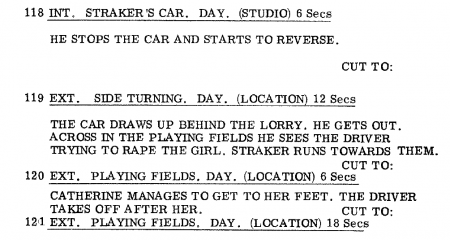Look, there’s something really good I want to tell you, but I don’t quite know how I need to express it in an academic manner. It’s all about the ATV science-fiction film series UFO (1970-1971).
Oh, before I tell you what I want to tell you, a wee while back I made reference to this series as ‘UFO (1970-1971)’, very much like I did at the end of that last sentence, and yet most reference works on the show – and certainly all the academic works I’ve seen – refer to it as UFO (1970-1973). Which is probably my fault…
Sorry.
Back in 198SomethingOrOther, I was attempting to assemble a fanzine episode guide to UFO with transmission dates. Because UFO was an ATV film series, I naturally believed that ATV would be the logical ITV region to seek out transmission dates; because it’s their series, and they would have had a vested interest in giving it decent exposure wouldn’t they? This was not, however, the case.
UFO had a bit of a false start. It was placed at 8pm on Wednesdays from 16 September 1970… but it didn’t really work in an 8pm slot… not when by Spring 1971 there were spin-off comics and toys aimed at the younger market. So, from February 1971, it was shifted to 5.15pm on Saturdays as a more juvenile friendly placing which would help shift issues of Countdown and Dinky SHADO Interceptor die-casts. But – content wise – that caused a problem as some of the UFO incidents still to air were a tad on the adult side. The Responsibility Seat featured a female character in a state of undress to create a compromising situation… while The Long Sleep depicted both recreational drugs and attempted rape. Not ideal as a follow-up to the classified football results. So, the two episodes weren’t scheduled and remained unaired by the end of the run in July 1971.
By the time ATV did find some suitable late night slots, it was March 1973 and this is where the two previously unscreened editions showed up. Hence UFO (1970-1973).
But to me, that’s instinctively wrong. If I glance at ‘1970-1973’ that suggests to me a show that ran for – maybe – three complete seasons. In fact, it really only ran for one [i] and the 1973 dates are more of a regional anomaly…
And talking of regional anomalies… if you lived in London, you’d possibly write UFO (1971-1975) because London Weekend Television held it back by a year compared to most of the country and then didn’t find enough post-watershed slots until almost four years after its debut. Or in the USA you might go for UFO (1972-1973) since it was September 1972 before the show went into syndication.
Anyway, that’s the years of transmission sorted out and I can now get back to the real business in hand of what I want to tell you. Although, I have to admit that I’m still worrying about how the Leeds-Harvard referencing system works while listening to SHADO interceptors being launched from moonbase. And my current crisis of faith is based around the format example which I’d highlighted previously:
Series title, number and Title of episode (if applicable). Year. Transmitting organisation/channel. Date and time of transmission.
It’s all very well saying ‘Transmitting organisation/channel’ and ‘Date and time of transmission’ but for somebody who’s been scouring TV listings since the late 1960s it feels instinctively to me like an incredibly flippant statement where I have supplementary questions that I should like to pose to Mx Leeds and Mx Harvard if they happen to be looking in.
Which transmission date do I use? Do I pick one consistent broadcaster and stick to that? And should that be the first broadcaster? Or the originating company? Or, do I use the earliest broadcast date regardless of broadcaster?
Actually, that’d be handy… because it would get my (1970-1973) down to (1970-1971) which is what feels right. You see, another ITV region – Anglia – screened The Responsibility Seat on 3 March 1971 and The Long Sleep on 1 April 1971.
But if I do that, that gives me the problem that sometimes you have two episodes debuting at the same time on the same day. That means that both The Square Triangle and Sub-Smash debut on 11 November 1970 – the former via Tyne Tees and Border, and the latter via ATV and Anglia. And that means that I don’t have a neat sequence of single instances…
To make matters even worse, UFO actually made its worldwide debut in Canada where CTV started screening it with Identified on 14 September 1970… two days before its commenced broadcast on ATV, Border and Tyne Tees.
So, do I need to ignore the ITV network altogether and look further afield…?
Part of my problem is that I see all this as data. I’ve been building databases for almost 40 years now – so I see most of the world as data. And I know that if I was building a database to house this data, a ‘programme’/’broadcast date’ relationship is a one-to-many (i.e. one programme can have many transmission dates) and not necessarily a simplistic one-to-one (i.e. a single broadcast).
What is a broadcast date actually telling me anyway? It depends on the degree of detail. The ATV air date for Identified of 16 September 1970 could just tell me broadly speaking that it’s an old programme or that it was aired early in the colour era of ITV or that it was pre-Star Wars (1977) or that it’s Post-War. Or it could tell me more precisely that it’s just over a year after BBC1 started screening Star Trek (1966-1969)[ii] or two years before the next series from Gerry Anderson (i.e. The Protectors (1972-1974)) and one year after his last one (The Secret Service (1969)). Or even more exactly that it was part of the autumn 1970 season for ATV. Or that it was the same evening that Annie Walker became the new landlady of the Rovers Return on the corner of Rosamund Street and Coronation Street (1960-).
Anyway, fortunately all I really wanted to tell you was that there’s this amazing music cue in the score for Identified (16 September 1970 [iii]. It’s this relentless pounding beat just before the interceptors are launched which really gets the pulse racing – so exciting!
And – what’s more – I’m sure it’s just as brilliant whether you heard it on 14 September 1970 in Canada or 16 September 1970 in the Midlands or 18 September 1971 in London or on whatever dates since you caught a late-night repeat or slipped the DVD or Blu-ray into the machine. So, please excuse me if – in this instance – I may not have cited the correct date.
Andrew Pixley is a retired data developer. For the last 30 years he’s written about almost anything to do with television if people will pay him – and occasionally when they won’t. And – yes – he did immediately take his new UFO soundtrack set and put together a spreadsheet to compare the cues to the previous releases. Nothing to do with filling time in lock-down – it’s just what he does anyway. Sad isn’t it?
Footnotes:
[i] Actually, they made a minimum order of 17 during 1969 believing that it could be sold to one of the US networks, and when that didn’t happen an additional nine were shot during 1970 so that it would be a more attractive syndication package of 26. So you could count it as two seasons if you wanted – but nobody really does and it was never aired as such. And that’s just confusing things which are confused enough already…
[ii] Or, if we’re doing UK dates, Star Trek (1969-1994) because we didn’t take Whom Gods Destroy until 19 January 1994.
[iii] That’s ATV by the way. I’ll stick to what I know. I seem to have started this mess in the first place…







